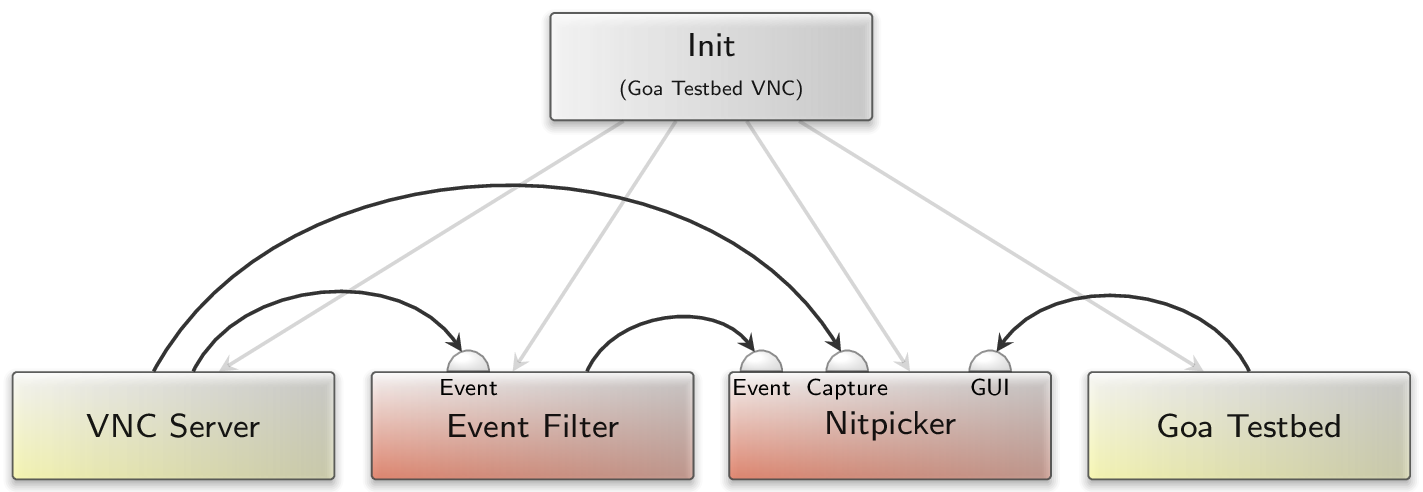Goa - Using a headless Sculpt as a remote test target
Goa's ability to run applications on a remote Sculpt system comes in handy for testing. However, switching between keyboards to control the remote-running application is a tiny inconvenience. My recent experiments with Sculpt on a ZimaBlade, which has no built-in display, thus motivated me to experiment with solutions for Sculpt as a truly remote test target.
The current release of Sculpt OS (24.04) comes with an integrated preset for turning the system into a remote test target for Goa. This allows running a Goa scenario on a remote Sculpt system. Goa automatically uploads the required files to the test system and establishes a telnet connection in order to extract the log output. However, GUI interaction still has to be done on the target system.
- Goa - Test running applications on Sculpt
Experimenting with Sculpt on a ZimaBlade single-board computer therefore motivated me to combine this with my VNC server. The latter was a bit dated, thus I updated our port of libvnc and took the opportunity to add the missing mouse-wheel support and (optional) password authentication. I've updated the corresponding article (linked below) accordingly.
- Remote desktop solution for Sculpt via VNC
With all ingredients at hand, I came up with two options for turning Sculpt into a truly remote test target.
Option 1: Combine VNC server with Goa testbed
As a first and straightforward option, I switched to the goa_testbed preset and started a Sculpt-global VNC server following these instructions.
This option provides access to the complete Sculpt OS including the Leitzentrale UI and is great if you want to change settings or restart the Goa testbed remotely.
Option 2: Integrate VNC server into Goa testbed
For this option, I created a separate depot package called goa_testbed_vnc. The package runtime bundles the goa_testbed with a separate Nitpicker and a VNC server as illustrated in the figure below. GUI applications run in this testbed will not be shown in the Sculpt UI. Instead, they are only visible via the VNC server. The additional event-filter component is required to translate non-printable key symbols into ASCII codes or into function-key unicodes. Printable characters are already submitted as unicodes by the VNC server. The package is available in my depot.

|
In order to use this package, I first create a copy of /config/presets/goa_testbed. In this copy, I replace jschlatow/pkg/goa_testbed/... by jschlatow/pkg/goa_testbed_vnc/2024-05-31. Furthermore, I add the following route to the goa_testbed child:
<service name="Nic" label_prefix="vnc"> <child name="nic_router" label="vnc"/> </service>
This route makes sure that the Nic session used by the internal VNC server appears with the label "vnc" at the Nic router. With this route in place, I can add the following to /config/nic_router in order to assign a fixed IP address to the VNC server and to add a corresponding port-forwarding rule.
<domain name="uplink"> [...] <tcp-forward port="5900" domain="vnc" to="10.0.59.2"/> </domain> <policy label="vnc" domain="vnc"/> <domain name="vnc" interface="10.0.59.1/24"> <dhcp-server ip_first="10.0.59.2" ip_last="10.0.59.2" dns_config_from="uplink"/> </domain>
Since goa_testbed_vnc uses its own nitpicker instance, I can also remove all routes to the wm child as well as the start nodes for window_layouter, wm, and themed_decorator. The resulting preset is available in my sculpt repository.
- Goa testbed vnc preset
-
https://codeberg.org/jschlatow/sculpt/src/branch/master/sculpt/deploy/goa_testbed_vnc
Using Goa with a VNC client
For both options, I added the --target-opt-sculpt-cmd command-line argument to Goa. This argument allows specifying an arbitrary command that is spawned just before Goa establishes the Telnet connection to the remote system. This can be utilised to automatically spawn a VNC client with goa run --target sculpt. The VNC client is automatically closed when the user closes the Telnet connection with ctrl+c.
Note that the command is supplied with the SERVER environment variable set to the value of --target-opt-sculpt-server (see goa help targets). With this option, I am able to run a Goa scenario on the remote system as follows:
goa run --target sculpt \ --target-opt-sculpt-server «sculpt-ip» \ --target-opt-sculpt-cmd 'gvncviewer $SERVER:0'


 Johannes Schlatow
Johannes Schlatow